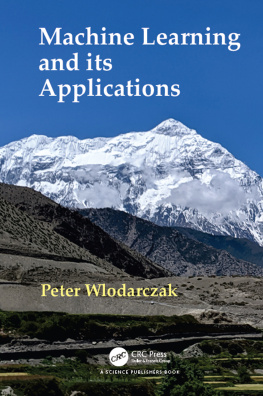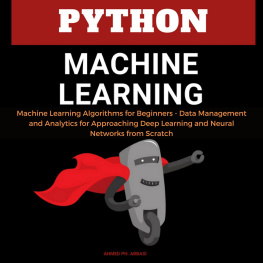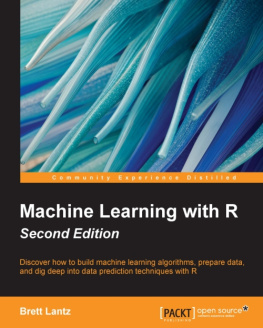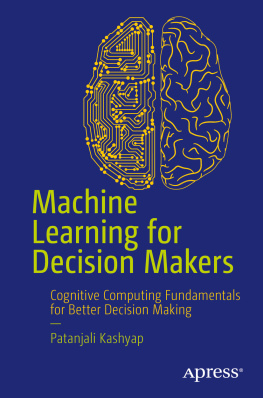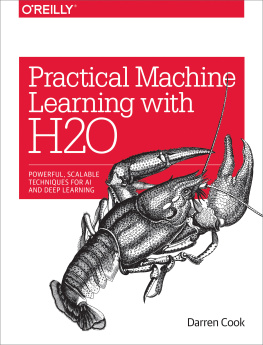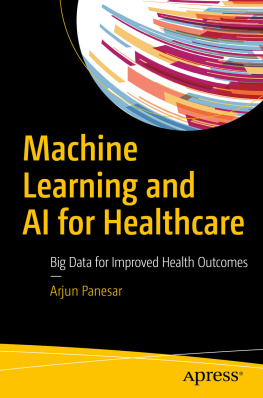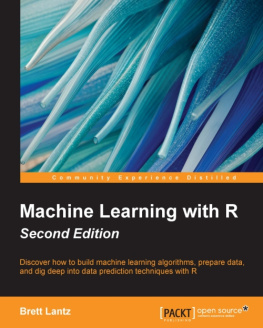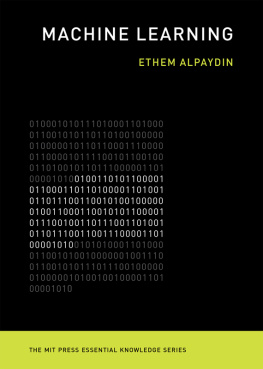Contents
Page List

Machine Learning and its Applications
Peter Wlodarczak
University of Southern Queensland
Toowoomba, Queensland, Australia

CRC Press
Taylor & Francis Group
6000 Broken Sound Parkway NW, Suite 300
Boca Raton, FL 33487-2742
2020 by Taylor & Francis Group, LLC
CRC Press is an imprint of Taylor & Francis Group, an Informa business
No claim to original U.S. Government works
Printed on acid-free paper
Version Date: 20190821
International Standard Book Number-13: 978-1-138-32822-8 (Hardback)
This book contains information obtained from authentic and highly regarded sources. Reasonable efforts have been made to publish reliable data and information, but the author and publisher cannot assume responsibility for the validity of all materials or the consequences of their use. The authors and publishers have attempted to trace the copyright holders of all material reproduced in this publication and apologize to copyright holders if permission to publish in this form has not been obtained. If any copyright material has not been acknowledged please write and let us know so we may rectify in any future reprint.
Except as permitted under U.S. Copyright Law, no part of this book may be reprinted, reproduced, transmitted, or utilized in any form by any electronic, mechanical, or other means, now known or hereafter invented, including photocopying, microfilming, and recording, or in any information storage or retrieval system, without written permission from the publishers.
For permission to photocopy or use material electronically from this work, please access www.copyright.com (http://www.copyright.com/) or contact the Copyright Clearance Center, Inc. (CCC), 222 Rosewood Drive, Danvers, MA 01923, 978-750-8400. CCC is a not-for-profit organization that provides licenses and registration for a variety of users. For organizations that have been granted a photocopy license by the CCC, a separate system of payment has been arranged.
Trademark Notice: Product or corporate names may be trademarks or registered trademarks, and are used only for identification and explanation without intent to infringe.
Library of Congress Cataloging-in-Publication Data
Names: Wlodarczak, Peter, author.
Title: Machine learning and its applications / Peter Wlodarczak, University of Southern Queensland, Toowoomba, Queensland, Australia.
Description: First edition. | Boca Raton, FL : CRC Press/Taylor & Francis Group, [2020] | Includes bibliographical references and index. | Summary: This book describes Machine Learning techniques and algorithms that have been used in recent real-world application. It provides an introduction to Machine Learning, describes the most widely used techniques and methods. It also covers Deep Learning and related areas such as function approximation or. The book gives real world examples where Machine Learning techniques are applied and describes the basic math and the commonly used learning techniques-- Provided by publisher.
Identifiers: LCCN 2019033419 | ISBN 9781138328228 (hardcover ; acid-free paper)
Subjects: LCSH: Machine learning.
Classification: LCC Q325.5 .W635 2020 | DDC 006.3/1--dc23
LC record available at https://lccn.loc.gov/2019033419
Visit the Taylor & Francis Web site at
http://www.taylorandfrancis.com
and the CRC Press Web site at
http://www.crcpress.com
For my parents
Artificial intelligence or AI, and in particular, machine learning has received a lot of attention in media due to the rapid advances we have seen in this area over the past few years. Progress in artificial intelligence has been slow in the 1990s and a certain disillusionment was noticeable in research since artificial intelligence did not seem to live up to the expectation. Since the beginning of the new century, machine learning has seen rapid progress due to new approaches, in particular, deep learning. Deep learning goes further back, however, due to recent advances in other areas, in particular, the development of graphics processing units that provide the necessary computing power, and the Internet, that made an unprecedented amount of data publicly available, machine learning has gained a lot of momentum and we have seen an incredible amount of new applications in many areas of research and in practice. Machine learning is used for spam filtering, for medical image analysis, for voice commands, for autonomously driving cars and to analyze sensor data for the Internet of Things just to name a few. Every high-end smart phone is now AI enabled. Deep learning is used to predict earthquakes, for automatic language translation, for automatic coloring of black and white movies and for forecasting in finance. The Mars rover Curiosity utilizes artificial intelligence to autonomously select inspection-worthy soil and rock samples with high accuracy. The list goes on.
Recently, machine learning also attracted a lot of attention due to visions of jobs being lost to machines, dangers of autonomous systems, such as robots who could turn evil, loss of control over existential infrastructure or even a war starting due to artificial intelligence. However, it should be noted that artificial intelligence, as the name suggests, is artificial and has nothing to do with human intelligence. A machine may be capable of recognizing whether an animal in a picture is a lion or a tiger, but it is not able to understand the concept behind what it recognized, i.e., it does not understand the concept of a living being. A deep learner is, in essence, a huge mathematical formula. It has nothing to do with how the human brain works, where biochemical processes are executed. An artificial neural network is inspired by nature. It has a grain of how we think the brain works and a lot of math thrown at it. Visions of machines replacing doctors in diagnosing a patient or lawyers in sentencing a perpetrator are probably premature. It is more likely that we will see artificial intelligence supporting a doctor or a lawyer in his daily work instead of replacing her or him in the near future.
However, we will likely see many more applications of artificial intelligence in areas that we have not thought of yet. Artificial intelligence and machine learning pose many interesting problems in practice and in research. The fact that we try to imitate nature gives us a better understanding of what problems nature had to solve during evolution. It also helps us to better understand how it solved them. However, how human learning works is still largely unknown. Before we have a better understanding of how the brain works, it is unlikely that we will be able to replace it, no matter how much math we apply.
When I started to work with machine learning there were excellent books explaining the math used in machine learning algorithms. There were also excellent books about data mining and knowledge discovery. Some of them are listed in the reference section. They can be used for studying and for reference. However, there were no books explaining the basic concepts behind machine learning and how they are applied in practice. It is important to understand the math and the algorithms used in machine learning. However, it is not necessary to know all the details about the algorithms to be able to effectively use them for real world problems. Machine learning has evolved over the past years to the point where a lot of the complexity is hidden in frameworks such as TensorFlow or Apache Mahout. A data scientist can use these frameworks without knowing the implementation details. Many popular programming languages have libraries with implementations that are ready to be used in programs. R, Python, Java or Scala have many different implementations of machine learning methods and the data scientist can continue using his preferred programming language by including the libraries that fit the purpose best. There are also tools, such as RapidMiner, Weka or Knime to name a few, where no programming skills are required and machine learning workflows can be created graphically. Obviously, next to the open source implementations, there are also commercial tools offered by different vendors to choose from.

